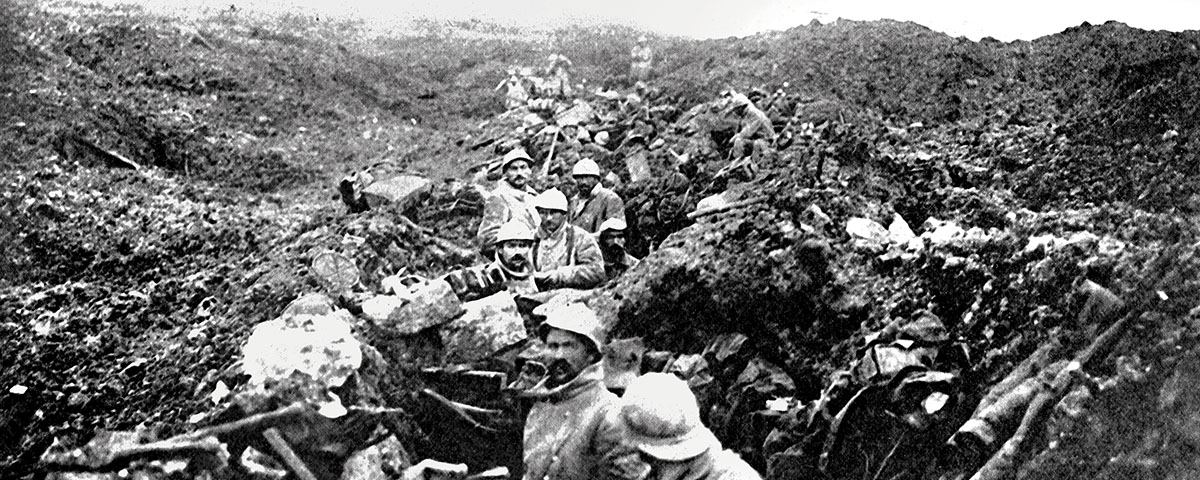There is no quick route by which one can approach Verdun. No superhighway passes through this declining town, nor do any of France’s fabled trains à grande vitesse stop here. One can only come to this battlefield slowly, by either a small four-car train or a narrow two-lane road. This is as it should be. More than 200,000 men died and 700,000 shed blood in these few square miles. One should not rush into a graveyard.
Although even less well known to Americans today than the almost-forgotten campaigns of the American Expeditionary Force in places like Saint-Mihiel and the Argonne Forest, Verdun actually represents the apogee of industrial slaughter on the Western Front. It is both the most costly battle of World War I and the longest, stretching from February 21, 1916, through mid-December of that year. Perhaps even more significant is the impact Verdun had on the people of France and their nation over the course of the century.
Verdun is and always has been more than just another small provincial town in northwestern France. Sitting astride the Meuse River valley, a traditional invasion route into France, Verdun has been repeatedly occupied and defended since the 3rd century…BC. The name itself literally means “fortified place.” In the 17th century no less a man than Louis XIV’s engineer, Vauban, the Enlightenment Age master of military fortifications, made it one of his centerpieces. And it was those same walls that even in the debacle of the Franco-Prussian War gave France some small measure of pride, as the garrison of Verdun withstood the sustained Prussian siege and never surrendered. For the French, Verdun in 1916 was more than a place, it was a national symbol of their resistance against the rising German tide, even before the battle started. Indeed, this patriotic fervor was central to the vicious nature of the battle itself.
If, as German General Erich von Falkenhayn contended after the war, the German plan really was to choose a place where they might “bleed the French white,” they chose well. Not only did the French military and citoyens have a strong emotional bond to the place, but also by 1916 the town occupied the most obvious salient along the French lines. Verdun served as a sort of a natural hinge in 1914, around which the German Schlieffen Plan and the countervailing French Plan XVII whirled. There was good reason for this: Verdun at the time was among the most highly fortified places in Europe.
Following solidification of the front lines by the winter of 1914, Verdun stuck out like, well, a sore thumb. The next year passed uneventfully, and, in one of the greatest ever examples of “good initiative, poor timing,” the materiel-stretched French more or less disarmed these forts in a then-quiet section of the front in late 1915.
Despite the subsequent 1,200-gun, 1 million–round initial surprise barrage and crush of three full German corps along the thinly held lines, the Verdun forts held. There should have been some inkling on the part of the Germans that this offensive was not going to be easy. But the Kaiser’s army was nothing if not determined. What followed was nine months of teetertotter slaughter in a place the French came to know as “The Cauldron” and the Germans “The Meat Grinder.”
Villages such as Fleury-devant-Douaumont, taken and retaken some 16 times over the summer of 1916, were wiped off the map. Fort Douaumont, taken almost by accident in the first few days of the assault, would claim thousands of casualties. On one hill alone, Les Eparges, some 10,000 men died on the French side alone. The soil of Verdun would absorb millions of gallons of blood. Aside from still-live munitions that restrict the visitor to the beaten path, these numbing casualties offer reason enough to stay the course when visiting.
When you arrive in Verdun, speak softly. As you walk the path through ruined Fleury, speak in whispers. And when you visit the ossuary, where the bones of some 130,000 unknowns rest forever, remember them in silence.
Originally published in the June 2007 issue of Military History. To subscribe, click here.





